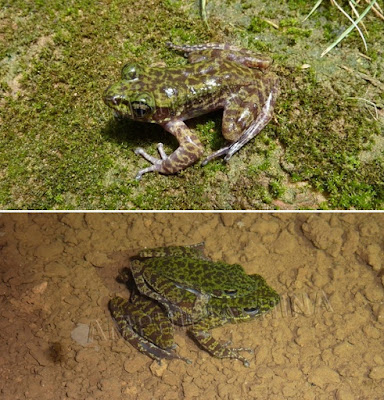[Most Recent Entries] [Calendar View]
Wednesday, March 22nd, 2017
| Time | Event | ||||||
| 2:03a | [Botany • 2017] Waltillia hatschbachii • A New Monotypic Genus in Tillandsioideae (Bromeliaceae) Arises from A Rediscovered, Allegedly Extinct Species from Brazil
Abstract A new monotypic genus of Bromeliaceae, Waltillia, is described to accommodate a single rediscovered species, Waltillia hatschbachii, thought to be extinct and formerly placed in either Vriesea or Alcantarea. This new genus is ecologically and morphologically distinct from the remaining genera of subfamily Tillandsioideae in its unique combination of characters including those of habit, leaf rosette, leaf blades, flowers, petals, anthers, pollen, stigma, and seeds. Phylogenetic DNA sequence analyses indicate that the individuals of W. hatschbachii form a monophyletic, highly supported group in sister position to Alcantarea s.str., with Alcantarea and Waltillia being sister to the clade containing Vriesea s.str. and Stigmatodon. Keywords: Alcantarea hatschbachii, Brazil, Campos Rupestres, Diamantina Plateau, DNA sequence phylogeny, morphology, new genus, Stigmatodon, Tillandsioideae, Vriesea hatschbachii, Vrieseinae, Monocots
TAXONOMY Waltillia Leme, Barfuss & Halbritter, gen. nov. Diagnosis:— This new genus differs from Alcantarea, Stigmatodon, and Vriesea by its unique combination of morphological characters, such as unappendaged petals 4 to 6 times longer than wide, forming a narrow campanulate corolla, pollen with the sulcus margins more or less well defined but not sharply cut, the sulcus covered with a kind of operculum of almost smooth exine elements with some perforations, stigma of the convolute-blade II type, and seeds with a basal appendage equalling to distinctly shorter than the apical appendage. Type:—Vriesea hatschbachii L. B. Sm. & R. W. Read.
Etymology:— This new genus honors the botanist Walter Till, Curator of the Herbarium of the Department of Botany and Biodiversity Research, University of Vienna, leading authority in Bromeliaceae in general, and in subfamily Tillandsioideae in especial. Waltillia hatschbachii (L. B. Smith & R. W. Read) Leme, Barfuss & Halbritter, comb. nov. Basionym:—Vriesea hatschbachii L. B. Smith & R. W. Read, Phytologia 30(5): 292. 1975. Type:—BRAZIL. Minas Gerais: Gouveia, side of a rock slope by BR 259, 21 January 1972, G. Hatschbach 29085, L.B. Smith & E. Ayensu (holotype US!, isotype MBM!). ≡ Alcantarea hatschbachii (L. B. Sm. & R. W. Read) Leme, Bromélia 2(3): 22. 1995, syn. nov. ..... Elton M. C. Leme, Heidemarie Halbritter and Michael H. J. Barfuss. 2017. Waltillia, A New Monotypic Genus in Tillandsioideae (Bromeliaceae) Arises from A Rediscovered, Allegedly Extinct Species from Brazil. Phytotaxa. 299;(1); 1–35. DOI: 10.11646/phytotaxa.299.1.1 | ||||||
| 8:01a | [Herpetology • 2015] Odorrana lipuensis • A New Species of Odorrana inhabiting complete darkness in A Karst Cave in Guangxi, China
Abstract A new species of the genus Odorrana is described from a completely dark karst cave of northeastern Guangxi, southern China. The new species, Odorrana lipuensis sp. nov., can be distinguished from its congeners by a combination of the following characters: medium size (SVL: 40.7–47.7 mm in males, 51.1–55.4 mm in females); tips of all but first finger expanded with circummarginal grooves; smooth, grass-green dorsum with irregular brown mottling; pineal body invisible; throat to upper abdomen with gray mottling; dorsal surfaces of limbs with brown bands; dorsolateral fold absent; tiny spinules on lateral body, temporal region, and anterior and posterior edge of tympanum; white nuptial pad present on finger I; males lacking vocal sacs; females having creamy yellow eggs, without black poles. Uncorrected sequence divergences between O. lipuensis sp. nov. and all homologous 16S rRNA sequences of Odorrana available on GenBank is equal to or greater than 4.9%. Currently, the new species is only known from the type locality. monophyletic group (Chen et al., 2013). All are known to be associated with mountain streams except O. wuchuanensis, which occurs in dark caves. During 2013–2014, eight Odorrana specimens were collected inside a completely dark karst cave in Lipu County, Guangxi Province, China. Morphologically, these specimens most closely resemble O. yizhangensis and O. schmackeri (Fei et al., 2009, 2012), but differ from O. yizhangensis, O. schmackeri and all other Odorrana from China and adjoining countries. They occur in a similar environment to O. wuchuanensis, inhabiting a dark cave, but are morphologically very different from O. wuchuanensis. Herein, we describe this population as a new species of Odorrana. 2. Materials and Methods 2.1 Sampling During 2013 and 2014, fieldwork was carried out in northeastern Guangxi, China (Figure 1A). Specimens were collected by hand, euthanized and fixed in 10% formalin and subsequently transferred to 75% ethanol for storage. Muscle tissues from three individuals were sampled and preserved in 100% ethanol for DNA extraction prior to fixing in formalin. All specimens and Keywords: Odorrana lipuensis sp. nov., karst cave, Guangxi, southern China Type locality: a completely dark karst cave of Lipu County, Guangxi, China (182 m a.s.l.) Etymology: Named after Lipu County, Guangxi Yunming Mo, Weicai Chen; Huaying Wu, Wei Zhang and Shichu Zhou. 2015. A New Species of Odorrana inhabiting complete darkness in A Karst Cave in Guangxi, China. Asian Herpetological Research. 6(1); 11–17. DOI: 10.16373/j.cnki.ahr.140054 |
| << Previous Day |
2017/03/22 [Calendar] |
Next Day >> |




